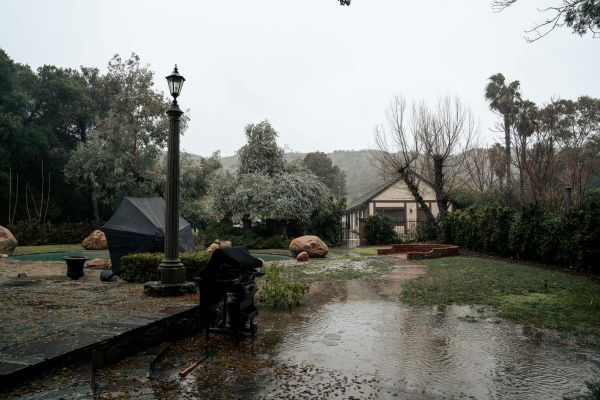Drainage does not need to be an eyesore that disrupts the aesthetic of your backyard. Thoughtful design and creative use of smart materials can turn a necessary drainage system into an attractive design element that adds beauty to your outdoor living space.

Diagnose the Issue
A good solution begins with identifying the cause of the problem. Areas where water pools against the side of a house, trail formation on lawns, or muddy patches after a storm all indicate different problems. Are the gutters overflowing, causing the water to flow towards the patio? Is the grade of the yard creating a path for water to run down to lower-lying areas? Once you understand the direction the water is flowing, you will have the ability to manage its flow in a manner that is aesthetically pleasing.
Use Gentle Slopes & Concealed Ditches
Instead of using large concrete ditches to direct water away from high-traffic areas, you could create gentle slopes that will naturally redirect water flow. An example would be a shallow swale (low-lying area) created by digging a slight incline and planting grasses, shrubs, or flowers in it. As water flows over the swale, it can absorb into the soil and then dry. Alternatively, you could install a linear drain, with a small amount of stone or wood covering it at grade. Not only will the linear drain effectively remove standing water from the area, but it will also become a unique design element that brings visual interest to your yard.
Decorative Gravel Bed
If you want to combine function with aesthetics, you can create a decorative bed using permeable materials. Using decorative gravel, along with native plants, you can create a bed that is visually appealing while providing effective drainage. You could place a thin layer of gravel stone in a shallow ditch within the bed, allowing water to wick away from the surface of the bed. Since the bed has been planted with native plants, they will easily absorb excess moisture. The decorative bed becomes a dual-purpose water collection/drainage feature. To add additional visual appeal, you can vary the texture of the materials used. For example, you can include large, rounded boulders and smaller, round pebbles in your bed to create visual contrast and add dimension. Selecting plants that are native to your region will ensure that the plants require minimal maintenance and blend seamlessly into your natural surroundings. Your decorative bed becomes a functional drainage system that also provides visual interest to your yard.
Rain Gardens – Function Meets Beauty
One of the most visually appealing methods of controlling runoff is the creation of a rain garden. A rain garden is a depressed area of land that is planted with species of plants that thrive in moist environments. These plants help absorb excess moisture rapidly. If properly designed, a rain garden can be visually stunning and bloom throughout the year, transforming a previously troublesome spot in your yard into a vibrant focal point. The shallow depression of the rain garden is specifically designed to attract water, which will then be absorbed by the plants and overflow into the next portion of your plan. The result is a beautiful sequence of water and plant life, working together in harmony.
Permeable Pavers: Drainage Meets Decking
If you have walkways or patios collecting water, traditional impermeable surfaces might be the culprit. Replacing them with permeable pavers offers a stylish fix that actually works. These pavers allow water to seep through into the ground rather than sitting on top. The gaps between the pavers can be filled with fine gravel or planted with moss or creeping thyme for a softer edge. The blended effect of structure and greenery makes the area inviting while solving the runoff challenge. Beyond function, your paths and patios gain texture, character, and an eco‑aware appeal.
Integrating Finishes and Accents
Once the major drainage work is in place, finesse the look with finishing touches. Choose materials that complement your home’s style. Bluestone for a classical feel or elongated concrete planks for something contemporary. Add stone or wood seating nearby so the drainage area becomes a place to linger. Lighting brings the feature to life at night, making it double as a landscape highlight rather than just a utility element. A shallow basin or decorative grate can cover access points in a subtle way. All of these details help the drainage feature feel intentionally designed.
Maintenance That Keeps It Looking Great
Even the most beautiful drainage solution needs some upkeep. Remove debris from gutters and downspouts so runoff remains consistent. Periodically check that slopes and channels remain clear and haven’t shifted from heavy rain or frost. For the planted areas, tidy dead leaves and plants in the season‑appropriate way, and add mulch annually for the rain garden bed to maintain soil health. Simply observing what happens during and after a rain event is one of the best habits you can adopt. It tells you exactly how your system is performing. With basic care, your yard will continue to be both functional and beautiful.
Transforming a drainage issue into an aesthetic asset adds value, personality, and resilience to your outdoor space. When you choose intentional materials, respect the natural flow of water, and treat the fix as design rather than remediation, your backyard evolves. You’ll end up with a space that invites visitors, withstands weather, and carries its own story. The result is a yard you’re proud of.

